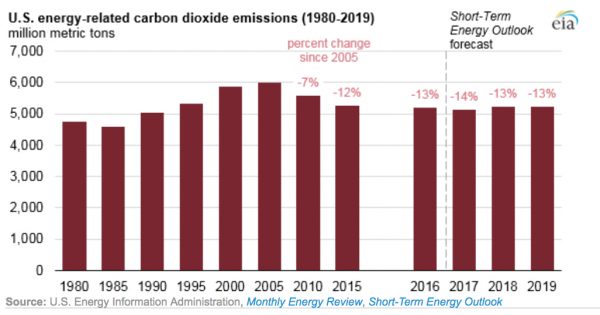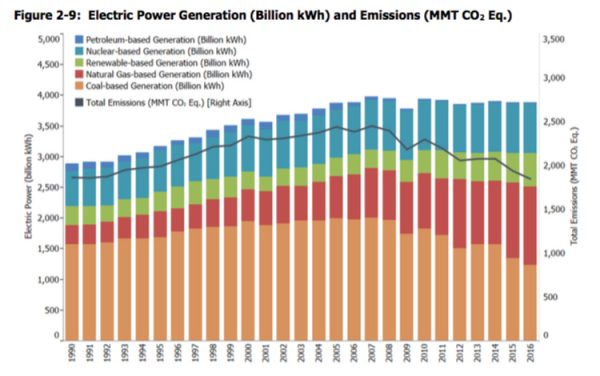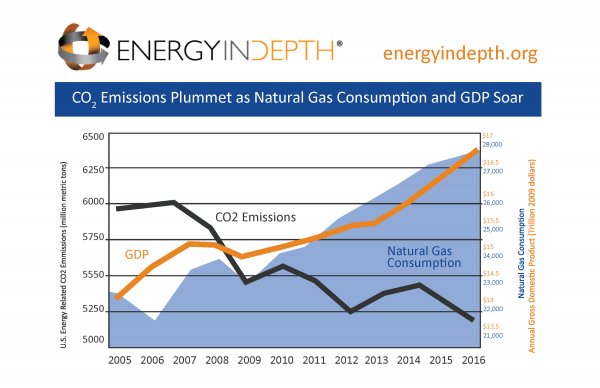The U.S. Energy Information Administration (EIA) last week reported that U.S. energy-related carbon dioxide emissions fell one percent from 2016 levels in 2017, continuing the downward trajectory that began about a decade ago.

As the above chart shows, the U.S. has reduced energy-related carbon emissions 14 percent since 2005, and the EIA has once again affirmed that these reductions are “mainly” attributable to increased natural gas use for electricity generation. From the EIA report:
“The underlying energy consumption trends that resulted in these changes—mainly because more electricity has been generated from natural gas than from other fossil fuels—have helped to lower the U.S. emissions level since 2005 because natural gas is a less carbon-intensive fuel than either coal or petroleum.”
The EIA has previously reported that nearly two-thirds of energy related CO2 emissions since 2005 can be attributed to natural gas use for electricity generation, as the following 2017 chart shows.

To further illustrate this point, the following chart from the U.S. Environmental Protection Agency’s draft 2018 Greenhouse Gas Inventory shows that natural gas’ share of the electricity generation mix jumped from 19 percent in 2005 to 32 percent in 2017.

This new government data is also just the latest evidence that the U.S. is leading the industrialized world in carbon reductions thanks to cheap and abundant natural gas made possible by fracking.
According to the new EIA data, the U.S. has achieved 861 million metric tons of CO2 reductions since 2005 at the same time natural gas consumption has increased 25 percent. Meanwhile, the EIA estimates that global energy-related CO2 emissions rose by 6,040 million metric tons (21%) between 2005 and 2017 at an annual rate of 1.6%. From the EIA report:
“Growth in global energy-related CO2 emissions from 2005 to 2017 was led by China, India, and other countries in Asia, which collectively increased by 6,260 million metric tons, while emissions in the rest of the world collectively decreased by 220 million metric tons.”

With all the hub-bub regarding the Trump administration’s plans to abandon the Paris Climate Accords, United Nations Energy Programme Chief Erik Solheim may have summed up what has occurred on the greenhouse gas reduction front in the U.S. over the last decade-plus best when he recently said:
“In all likelihood, the United States of America will live up to its Paris commitment, not because of the White House, but because of the private sector.”
Translation: America is reducing emissions because of affordable abundant natural gas made possible by fracking, which has also helped U.S. GDP grow 20.4 percent since 2005. No other major industrialized country can boast this historic and unprecedented decoupling trend.

So as the “Keep It In the Ground” movement continues to push for a completely impractical 100 percent renewable transition, it is important to keep the words of pragmatic leaders such as former Democratic Virginia Gov. Terry McAuliffe in mind:
“You’re reducing carbon emissions by using natural gas,” McAuliffe recently told Axios. “… That’s a move in the right direction. We can’t go 100% renewables in Virginia. It’s laughable to even discuss it.”